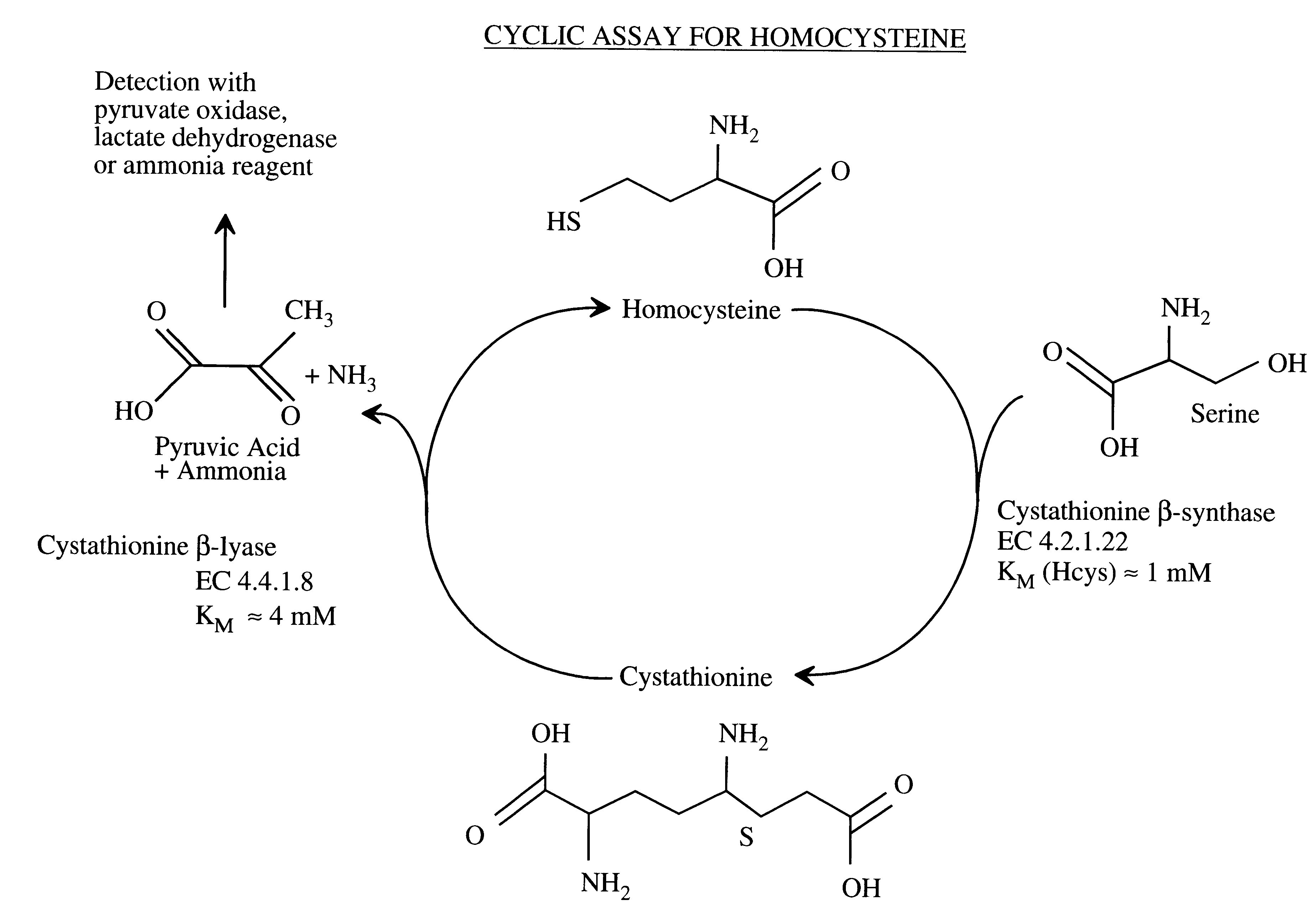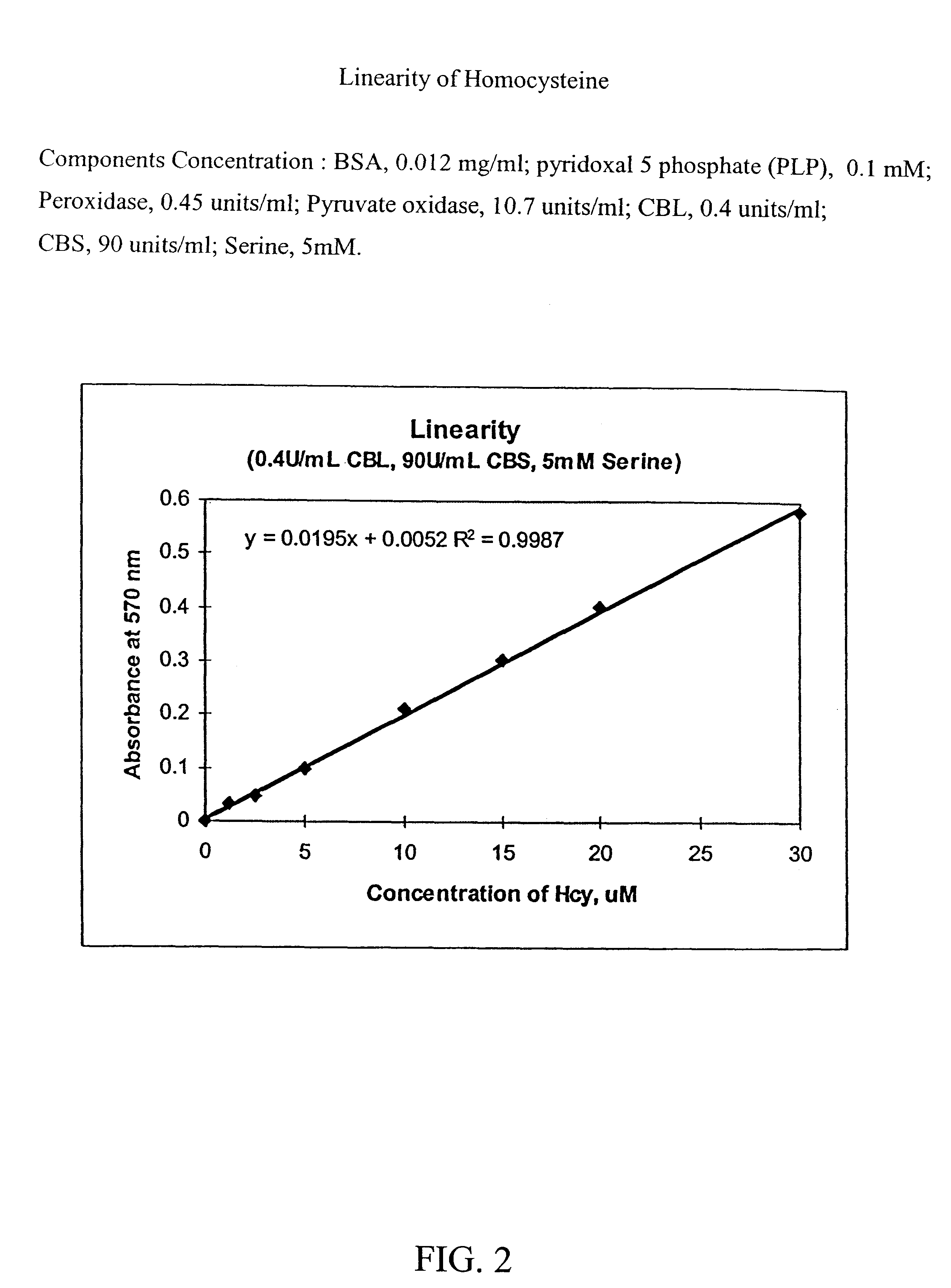Method for the determination of homocysteine
- Summary
- Abstract
- Description
- Claims
- Application Information
AI Technical Summary
Benefits of technology
Problems solved by technology
Method used
Image
Examples
examples
I. The CBL Enzymes:
A. Procedure for Cloning CBL
The pLC4-14 plasmid carrying the metC gene was isolated from ATCC Clone #37384 (J. R. Uren, Proc. Natl. Acad. Sci. USA 68: 367-371, 1971) using techniques described in Maniatis et al., Molecular Cloning, A Laboratory Manual, 2d, Cold Spring Harbor Laboratory Press (1989). The metC gene was cloned from the plasmid by PCR using primers synthesized according to the published DNA sequence. In addition, restriction enzyme sites were added at the N-and C-termini that were suitable for cloning the metC cDNA into an appropriate expression vector. PCR primers were synthesized and had the following 5'-3' sequences: Forward Primer (added an Nde I site at the ATG start codon of metC) GGG AAT TCC ATA TGG CGG ACA AAA AGC TTG ATA CTC (SEQ ID NO: 1) Reverse Primer--(added a BamHI site after the stop codon of metC) CGC GGA TCC AAA AGT GGC AAT GTT ATA CAA TTC GCG C (SEQ ID NO: 2). The PCR products were digested with Nde I and BamH I and ligated into a la...
first embodiment
A. A
Component Concentration* Trinder Reagent: Tris (pH 8.0) 0.1M 4-aminoantipyrine (4-AAP) 1.6 mM N-ethyl-N-(2 hydroxy-3-sulfopropyl)- 1.6 mM m-toluidine (TOOS) Thiamine pyrophosphate (TPP) 0.77 mM MgCl.sub.2 2.6 mM KH.sub.2 PO.sub.4 19.3 mM Enzymes & Cofactors: BSA 0.012 mg / mL Pyridoxal 5' phosphate (PLP) 0.1 mM Peroxidase 0.45 U / mL pyruvate oxidase 10.7 U / mL CBL 0.4 U / mL CBS 90 U / mL Serine: Serine 5 mM *Concentration is the final concentration in the Reagent
Enzymes and Cofactors are added to the Trinder reagent just prior to use. Enzymes and Cofactors are stored as stocks.
5 .mu.L serine stock (230 mM) and 25 .mu.L homocysteine containing Sample are added to reaction well.
200 .mu.L of reagent (Trinder+Enzymes & Cofactors) is added to the serine and homocysteine containing sample.
Reaction is incubated at 37.degree. C. (with mixing) for 20 minutes.
Color development is measured at 570 nm.
The calculated linearity of homocysteine concentration is shown in FIG. 2. In this figure, the abs...
second embodiment
B. A
Plasma and / or serum samples containing homocysteine were reduced using 2.5 mM DTT in the buffer containing 12.5 mM sodium citrate buffer at pH 7.8, 1% Triton, and 0.5 mM EDTA. The treated solution was capped and incubated for 20 minutes at 25.degree. C. then was uncapped and placed on the analyzer wheel. 20 microliters of sample and 5 microliters of water were added to 72 microliters of Reagent 1 and 92 microliters of Reagent 2. Reagent 1 was added at time point T1 (0 minutes), and Reagent 2 was added at T2 (about 20 seconds afterwards). Read points were at 25 and 50 (about 8 minutes). The assay was read at 550 nm, using the Cobas Mira analyzer.
Reagent composition was as follows:
R1 Reagent Composition R2 Reagent Composition 2.56 mM serine 2.42 U / mL CBL 1.15 U / mL peroxidase 0.2 mM PLP 27.3 U / mL pyruvate oxidase 360 U / mL CBS 10 mg / mL BSA 10 mg / mL BSA 127.8 mM Tris buffer at pH 7.8 100 mM Tris buffer at pH 7.8 6.6 mM MgCl.sub.2 3.2 mM TOOS 3.4 mM 4-AAP 80 mg / ml Gentamycin 49.3 mM K...
PUM
 Login to View More
Login to View More Abstract
Description
Claims
Application Information
 Login to View More
Login to View More - R&D
- Intellectual Property
- Life Sciences
- Materials
- Tech Scout
- Unparalleled Data Quality
- Higher Quality Content
- 60% Fewer Hallucinations
Browse by: Latest US Patents, China's latest patents, Technical Efficacy Thesaurus, Application Domain, Technology Topic, Popular Technical Reports.
© 2025 PatSnap. All rights reserved.Legal|Privacy policy|Modern Slavery Act Transparency Statement|Sitemap|About US| Contact US: help@patsnap.com



